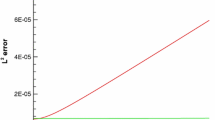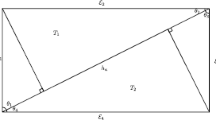Abstract
A new symmetric discontinuous Galerkin method for second order elliptic problems is analyzed. We show that the numerical method is stable for any positive penalty parameter and converges with optimal order provided the exact solution is sufficiently regular. These results are also shown to hold for some non-positive penalty parameters. Numerical experiments are presented that support the theoretical results.


Similar content being viewed by others
Notes
The IP methods can also be derived from this procedure [1].
References
Arnold, D., Brezzi, F., Cockburn, B., Marini, D.: Unified analysis of discontinuous Galerkin methods for elliptic problems. SIAM J. Numer. Anal. 39, 1749–1779 (2001)
Baker, G.A.: Finite element methods for elliptic equations using nonconforming elements. Math. Comput. 31, 45–59 (1977)
Bassi, F., Rebay, S.: A high-order accurate discontinuous finite element method for the numerical solution of the compressible Navier–Stokes equations. J. Comput. Phys. 131, 267–279 (1997)
Bassi, F., Rebay, S., Mariotti, G., Pedinotti, S., Savini, M.: A high-order accurate discontinuous finite element method for inviscid and viscous turbomachinery flows. In: Decuypere, R., Dibelius, G. (eds.) Proceedings of 2nd European Conference on Turbomachinery, Fluid Dynamics and Thermodynamics, pp. 99–108. Technologisch Instituut, Antwerpen, Belgium (1997)
Brenner, S.C., Scott, L.R.: The Mathematical Theory of Finite Element Methods, 3rd edn. Springer, Berlin (2008)
Castillo, P., Cockburn, B., Perugia, I., Schötzau, D.: An a priori error analysis of the local discontinuous Galerkin method for elliptic problems. SIAM J. Numer. Anal. 38(5), 1676–1706 (2000)
Castillo, P., Cockburn, B., Schötzau, D., Schwab, C.: Optimal a priori error estimates for the \(hp\)-version of the local discontinuous Galerkin method for convectiondiffusion problems. Math. Comput. 71, 455–478 (2002)
Ciarlet, P.G.: The Finite Element Method for Elliptic Problems. North-Holland, Amsterdam (1978)
Cockburn, B., Shu, C.-W.: The local discontinuous Galerkin method for time-dependent convection-diffusion systems. SIAM J. Numer. Anal. 35(6), 2440–2463 (1998)
Cockburn, B., Dong, B.: An analysis of the minimal dissipation local discontinuous Galerkin method for convection-diffusion problems. J. Sci. Comput. 32(2), 233–262 (2007)
Douglas Jr., J., Dupont, T.: Interior Penalty Procedures for Elliptic and Parabolic Galerkin Methods. Lecture Notes in Phys. 58. Springer, Berlin (1976)
Feng, X., Lewis, T., Neilan, M.: Finite element differential calculus and applications to numerical solutions of linear and nonlinear partial differential equations. arXiv:1302.6984 [math.NA]
Larson, M.G., Niklasson, A.J.: Analysis of a family of discontinuous Galerkin methods for elliptic problems: the one dimensional case. Numer. Math. 99, 113–130 (2004)
Larson, M.G., Niklasson, A.J.: Analysis of a non symmetric discontinuous Galerkin method for elliptic problems: stability and energy error estimates. SIAM J. Numer. Anal. 42(1), 252–264 (2004)
Nitsche, J.A.: Über ein Variationspirinzip zur Lösung Dirichlet-Problemen bei Verwendung von Teilräumen, die keinen Randbedingungen unteworfen sind. Abh. Math. Sem. Univ. Hamburg 36, 9–15 (1971)
Oden, J.T., Babuška, I., Baumann, C.E.: A discontinuous hp finite element method for diffusion problems. J. Comput. Phys. 146, 491–519 (1998)
Rivière, B.: Discontinuous Galerkin Methods for Solving Elliptic and Parabolic Equations, Theory and implementation. Frontiers in Applied Mathematics, vol. 35. SIAM, Philadelphia, PA (2008)
Rivière, B., Wheeler, M.F., Girault, V.: Improved energy estimates for interior penalty, constrained and discontinuous Galerkin methods for elliptic problems. I. Comput. Geosci. 3(3–4), 337–360 (1999)
Rivière, B., Wheeler, M.F., Girault, V.: A priori error estimates for finite element methods based on discontinuous approximation spaces for elliptic problems. SIAM J. Numer. Anal. 39(3), 902–931 (2001)
Scott, L.R., Zhang, S.: Finite element interpolation of non smooth functions satisfying boundary conditions. Math. Comput. 54(190), 483–493 (1990)
Wheeler, M.F.: An elliptic collocation-finite element method with interior penalties. SIAM J. Numer. Anal. 15, 152–161 (1978)
Acknowledgments
This work was partially supported by the NSF through grants DMS-071083 (Lewis) and DMS-1238711 (Neilan).
Author information
Authors and Affiliations
Corresponding author
Appendix: An Auxiliary Result
Appendix: An Auxiliary Result
Lemma 8
Let \(T\) be a \(d\)-dimensional simplex, and let \(e\subset \partial T\) be an arbitrary \((d-1)\)-dimensional sub-simplex of \(T\). Then any \(v_h\in \mathbb P _r(T)\) is uniquely determined by the following values
Proof
Since \(\dim \mathbb P _{r-1}(T) +\dim \mathbb P _r(e) = \left( \begin{array}{c}{d+r-1}\\ {d}\end{array}\right) +\left( \begin{array}{c}{d+r-1}\\ {d-1}\end{array}\right) = \left( \begin{array}{c}{d+r}\\ {d}\end{array}\right) = \mathbb P _r(T)\), it suffices to show that if \(v_h\) vanishes at the values (49), then \(v_h\) is identically zero.
If \(v_h\) vanishes at the values listed in (49b), then we easily conclude that \(v_h|_e = 0\). Therefore, we may write \(v_h = \lambda _e r_h\) for some \(r_h\in \mathbb P _{r-1}(T)\), where \(\lambda _e\) is the barycentric coordinate satisfying \(\lambda _e|_e = 0\). Since \(\lambda _e>0\) in \(T\), we conclude from (49a) that \(v_h\equiv 0\). \(\square \)
Rights and permissions
About this article
Cite this article
Lewis, T., Neilan, M. Convergence Analysis of a Symmetric Dual-Wind Discontinuous Galerkin Method. J Sci Comput 59, 602–625 (2014). https://doi.org/10.1007/s10915-013-9773-1
Received:
Revised:
Accepted:
Published:
Issue Date:
DOI: https://doi.org/10.1007/s10915-013-9773-1




